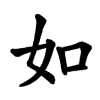Definify.com
Definition 2025
作
作
| ||||||
|---|---|---|---|---|---|---|
Translingual
| Stroke order | |||
|---|---|---|---|

| |||
Han character
作 (radical 9 人+5, 7 strokes, cangjie input 人竹尸 (OHS), four-corner 28211, composition ⿰亻乍)
References
- KangXi: page 99, character 7
- Dai Kanwa Jiten: character 518
- Dae Jaweon: page 210, character 1
- Hanyu Da Zidian: volume 1, page 134, character 6
- Unihan data for U+4F5C
Chinese
|
simp. and trad. |
作 | |
|---|---|---|
Glyph origin
| Historical forms of the character 作
| ||||||||||||||||||||||||
|---|---|---|---|---|---|---|---|---|---|---|---|---|---|---|---|---|---|---|---|---|---|---|---|---|
| Oracle bone script | Bronze inscriptions | Bamboo and silk script | Large seal script | Small seal script | ||||||||||||||||||||
 |
 |
 |
 |
 |
||||||||||||||||||||
| ||||||||||||||||||||||||
|
References:
Mostly from Richard Sears' Chinese Etymology site (authorisation),
| ||||||||||||||||||||||||
| Characters in the same phonetic series (乍) (Zhengzhang, 2003) | |
|---|---|
| Old Chinese | |
| 作 | *ʔsaːɡs, *ʔsaːɡs, *ʔsaːɡ |
| 鲊 | *ʔsraːʔ |
| 痄 | *ʔsraːʔ |
| 厏 | *ʔsraːʔ, *zraːʔ |
| 詐 | *ʔsraːɡs |
| 咋 | *ʔsraːɡs, *zraːɡ, *ʔsreːɡ |
| 笮 | *ʔsraːɡs, *zaːɡ, *ʔsraːɡ |
| 榨 | *ʔsraːɡs |
| 炸 | *ʔr'aːɡs, *zreːb |
| 乍 | *zraːɡs |
| 拃 | *ʔsraːnʔ |
| 酢 | *sʰaːɡs, *zaːɡ |
| 祚 | *zaːɡs |
| 胙 | *zaːɡs |
| 阼 | *zaːɡs |
| 飵 | *zaːɡs, *zaːɡ |
| 秨 | *zaːɡs, *zaːɡ |
| 迮 | *ʔsaːɡ, *ʔsraːɡ |
| 柞 | *ʔsaːɡ, *zaːɡ |
| 昨 | *zaːɡ |
| 怍 | *zaːɡ |
| 砟 | *zaːɡ |
| 莋 | *zaːɡ |
| 岝 | *zaːɡ, *zraːɡ |
| 鈼 | *zaːɡ |
| 筰 | *zaːɡ |
| 葃 | *zaːɡ, *zreːɡ, *zaɡ |
| 舴 | *ʔr'aːɡ, *ʔsraːɡ |
| 窄 | *ʔsraːɡ |
| 蚱 | *ʔsraːɡ |
| 齚 | *zraːɡ |
| 泎 | *zraːɡ |
Phono-semantic compound (形聲, OC *ʔsaːɡs, *ʔsaːɡs, *ʔsaːɡ) : semantic 亻 (“man”) + phonetic 乍 (OC *zraːɡs).
Etymology
Derivative: 做 (“to do”) (the departing-tone variant).
Pronunciation 1
- Mandarin
- Cantonese (Jyutping): zok3
- Hakka (Sixian, PFS): chok
- Min Dong (BUC): cáuk
- Min Nan (POJ): chok / choh / chòe / chò
- Wu (Wiktionary): tsoq (T4)
- Mandarin
- (Standard Chinese, Beijing)+
- Pinyin:
- Zhuyin: ㄗㄨㄛˋ
- Wade-Giles: tso4
- Gwoyeu Romatzyh: tzuoh
- IPA (key): /t͡su̯ɔ⁵¹/
-

- (Standard Chinese, Beijing)+
- Cantonese
- (Standard Cantonese, Guangzhou)+
- Jyutping: zok3
- Yale: jok
- Cantonese Pinyin: dzok8
- IPA (key): /t͡sɔːk̚³/
- (Standard Cantonese, Guangzhou)+
- Hakka
- (Sixian, incl. Miaoli and Meinong)
- Pha̍k-fa-sṳ: chok
- Hakka Romanization System: zog`
- Hagfa Pinyim: zog5
- IPA: /t͡sok̚²/
- (Sixian, incl. Miaoli and Meinong)
- Min Dong
- (Fuzhou)
- Bàng-uâ-cê: cáuk
- IPA (key): /t͡sɔuʔ²⁴/
- (Fuzhou)
- Min Nan
- (Hokkien: Xiamen, Quanzhou, Zhangzhou, mainstream Taiwanese)
- Pe̍h-ōe-jī: chok
- Tâi-lô: tsok
- Phofsit Daibuun: zog
- IPA (Xiamen): /t͡sɔk̚³²/
- IPA (Quanzhou): /t͡sɔk̚⁵/
- IPA (Zhangzhou): /t͡sɔk̚³²/
- IPA (Taipei): /t͡sɔk̚³²/
- IPA (Kaohsiung): /t͡sɔk̚³²/
- (Hokkien: Xiamen, Quanzhou, Zhangzhou, mainstream Taiwanese)
- Pe̍h-ōe-jī: choh
- Tâi-lô: tsoh
- Phofsit Daibuun: zoiq
- IPA (Xiamen): /t͡sɤʔ³²/
- IPA (Quanzhou): /t͡sɤʔ⁵/
- IPA (Zhangzhou): /t͡sɤʔ³²/
- IPA (Taipei): /t͡soʔ³²/
- IPA (Kaohsiung): /t͡sɤʔ³²/
- (Hokkien: Xiamen, Taipei)
- Pe̍h-ōe-jī: chòe
- Tâi-lô: tsuè
- Phofsit Daibuun: zoex
- IPA (Xiamen): /t͡sue²¹/
- IPA (Taipei): /t͡sue¹¹/
- (Hokkien: Zhangzhou, Kaohsiung)
- Pe̍h-ōe-jī: chò
- Tâi-lô: tsò
- Phofsit Daibuun: zoix
- IPA (Zhangzhou): /t͡sɤ²¹/
- IPA (Kaohsiung): /t͡sɤ²¹/
- Note: chok - literary; choh - vernacular; chòe/chò - substitute for 做.
- (Hokkien: Xiamen, Quanzhou, Zhangzhou, mainstream Taiwanese)
- Wu
- (Shanghainese)
- Wiktionary: tsoq (T4)
- IPA (key): /t͡sʊʔ⁵⁵/
- (Shanghainese)
- Dialectal data▼
| Variety | Location | 作 |
|---|---|---|
| Mandarin | Beijing |
/t͡suo⁵¹/ /t͡suo⁵⁵/ |
| Harbin |
/t͡suo⁵³/ 工~ /t͡suo²⁴/ ~料 |
|
| Tianjin |
/t͡suo⁵³/ 工~ /t͡suo²¹/ ~坊 |
|
| Jinan |
/t͡suə²¹³/ /t͡suə²¹/ |
|
| Qingdao |
/t͡suə⁴²/ ~息 /t͡suə⁵⁵/ 工~ |
|
| Zhengzhou |
/t͡suo²⁴/ 工~ /t͡suo⁴²/ ~料 |
|
| Xi'an | /t͡suo²¹/ | |
| Xining | /t͡su⁴⁴/ | |
| Yinchuan | /t͡suə¹³/ | |
| Lanzhou | /t͡suə¹³/ | |
| Ürümqi | /t͡suɤ²¹³/ | |
| Wuhan | /t͡suo²¹³/ | |
| Chengdu | /t͡so³¹/ | |
| Guiyang | /t͡so²¹/ | |
| Kunming | /t͡so³¹/ | |
| Nanjing | /t͡soʔ⁵/ | |
| Hefei | /t͡suɐʔ⁵/ | |
| Jin | Taiyuan | /t͡suaʔ²/ |
| Pingyao | /t͡sʌʔ¹³/ | |
| Hohhot | /t͡suaʔ⁴³/ | |
| Wu | Shanghai | /t͡soʔ⁵/ |
| Suzhou | /t͡soʔ⁵/ | |
| Hangzhou | /t͡soʔ⁵/ | |
| Wenzhou | /t͡so²¹³/ | |
| Hui | Shexian | /t͡sɔʔ²¹/ |
| Tunxi | /t͡so⁵/ | |
| Xiang | Changsha | /t͡so²⁴/ |
| Xiangtan | /t͡so²⁴/ | |
| Gan | Nanchang | /t͡sɔʔ⁵/ |
| Hakka | Meixian | /t͡sok̚¹/ |
| Taoyuan | /t͡sok̚²²/ | |
| Cantonese | Guangzhou | /t͡sɔk̚³/ |
| Nanning | /t͡sɔk̚³³/ | |
| Hong Kong | /t͡sɔk̚³/ | |
| Min | Xiamen (Min Nan) |
/t͡sɔk̚³²/ /t͡soʔ³²/ |
| Fuzhou (Min Dong) | /t͡sɔuʔ²³/ | |
| Jian'ou (Min Bei) | /t͡sɔ²⁴/ | |
| Shantou (Min Nan) |
/t͡sak̚²/ /t͡soʔ²/ |
|
| Haikou (Min Nan) | /to⁵⁵/ |
| Rime | |||
|---|---|---|---|
| Character | 作 | 作 | 作 |
| Reading # | 1/3 | 2/3 | 3/3 |
| Initial (聲) | 精 (13) | 精 (13) | 精 (13) |
| Final (韻) | 模 (23) | 歌 (94) | 鐸 (103) |
| Tone (調) | Departing (H) | Departing (H) | Checked (Ø) |
| Openness (開合) | Open | Open | Open |
| Division (等) | I | I | I |
| Fanqie | 臧祚切 | 則箇切 | 則落切 |
| Reconstructions | |||
| Zhengzhang Shangfang |
/t͡suoH/ | /t͡sɑH/ | /t͡sɑk̚/ |
| Pan Wuyun |
/t͡suoH/ | /t͡sɑH/ | /t͡sɑk̚/ |
| Shao Rongfen |
/t͡soH/ | /t͡sɑH/ | /t͡sɑk̚/ |
| Edwin Pulleyblank |
/t͡sɔH/ | /t͡saH/ | /t͡sak̚/ |
| Li Rong |
/t͡soH/ | /t͡sɑH/ | /t͡sɑk̚/ |
| Wang Li |
/t͡suH/ | /t͡sɑH/ | /t͡sɑk̚/ |
| Bernard Karlgren |
/t͡suoH/ | /t͡sɑH/ | /t͡sɑk̚/ |
| Expected Mandarin Reflex |
zù | zuò | zuo |
| Baxter-Sagart system 1.1 (2014) | ||
|---|---|---|
| Character | 作 | 作 |
| Reading # | 1/2 | 2/2 |
| Modern Beijing (Pinyin) |
zuò | zuò |
| Middle Chinese |
‹ tsak › | ‹ tsuH › |
| Old Chinese |
/*[ts]ˤak/ | /*[ts]ˤak-s/ |
| English | do, work | do, work |
Notes for Old Chinese notations in the Baxter-Sagart system: * Parentheses "()" indicate uncertain presence; | ||
| Zhengzhang system (2003) | |||
|---|---|---|---|
| Character | 作 | 作 | 作 |
| Reading # | 1/3 | 2/3 | 3/3 |
| No. | 16641 | 16653 | 16661 |
| Phonetic component |
乍 | 乍 | 乍 |
| Rime group |
暮 | 暮 | 鐸 |
| Rime subdivision |
0 | 0 | 0 |
| Corresponding MC rime |
佐 | 作 | 作 |
| Old Chinese |
/*ʔsaːɡs/ | /*ʔsaːɡs/ | /*ʔsaːɡ/ |
| Notes | 祚原誤衤旁巾箱本不誤 | 乍轉註字 | |
Definitions
作
- † to get up (from a place)
- † to get up (in the morning) and go to work
- † to begin to grow; to come into being
- † to arise; to come about; to happen; to occur; to break out
- to do; to perform; to carry out
- to work; to exert oneself
- to make; to manufacture
- to compose; to write
- 作者 ― zuòzhě ― author
- † to brace oneself; to boost
- † to feign; to pretend
- to work as; to serve as
- † to build; to construct
- † to play; to perform
- † to emit; to give out
- † to start; to launch
- † to be like; similar
- †Alternative form of 詛/诅 (zǔ, “to curse; to damn”).
- work; composition; article
- †affair; matter
- †measure; action
Synonyms
Compounds
|
|
|
Pronunciation 2
- Mandarin
- (Standard Chinese, Beijing)+
- Pinyin:
- Zhuyin: ㄗㄨㄛ
- Wade-Giles: tso1
- Gwoyeu Romatzyh: tzuo
- IPA (key): /t͡su̯ɔ⁵⁵/
- (Standard Chinese, Beijing)+
Definitions
作
- workshop; studio; workroom
- (neologism, originally dialectal) contrived; artificial; affected; pretentious; dramatic; high-maintenance
Compounds
Japanese
Kanji
Readings
- Goon: さく (saku), さ (sa)
- Kan’on: さく (saku), さ (sa)
- Kun: つくる (作る, tsukuru), つくり (作り, 作, tsukuri)
- Nanori: くり (kuri), さか (saka), づくり (zukuri), とも (tomo), なお (nao), はぎ (hagi), まさか (masaka)
Compounds
Related terms
- 抜け作
Etymology 1
| Kanji in this term |
|---|
| 作 |
|
さく Grade: 2 |
| on'yomi |
From Middle Chinese 作 (tsak, “to do, to work”). Compare modern Cantonese reading zok3, Wu tsoq (T4).
Pronunciation 1
Noun
- a work, a production (particularly a cultural work, such as a work of art, of literature, or of theatre)
Pronunciation 2
Noun
Etymology 2
| Kanji in this term |
|---|
| 作 |
|
つく(り) Grade: 2 |
| kun'yomi |
The 連用形 (ren'yōkei, “continuative or stem form”) of verb 作る (tsukuru, “to make; to build; to work the land, to grow something”), itself from Old Japanese.[2]
Pronunciation 1
Noun
作 (hiragana つくり, romaji tsukuri)
- the workmanship or make of something, how something is made
- 作りのいい家具
- tsukuri no ii kagu
- furniture of good make or workmanship, well-made furniture
- 作りのいい家具
- make-up, dress, comportment: how one dresses and comports oneself
- 派手な作りは嫌いだ。
- Hade na tsukuri wa kirai da.
- I dislike colorful / flashy dress.
- 派手な作りは嫌いだ。
- a helping or serving of fresh sashimi, usually several slices
- 鮭の作りを楽しみにしている。
- Shake no tsukuri o tanoshimi ni shite iru.
- I'm looking forward to a helping of salmon sashimi.
- 鮭の作りを楽しみにしている。
Usage notes
More often spelled with the okurigana, as 作り.
Pronunciation 2
Suffix
作 (hiragana づくり, romaji -zukuri)
- the making of something, particularly as in cultivation
- 庭作り、バラ作り
- niwazukuri, barazukuri
- gardening / garden cultivation, rose cultivation / growing roses
- 庭作り、バラ作り
Usage notes
More often spelled with the okurigana, as 作り.
References
- 1 2 3 2006, 大辞林 (Daijirin), Third Edition (in Japanese), Tōkyō: Sanseidō, ISBN 4-385-13905-9
- ↑ 1988, 国語大辞典(新装版) (Kokugo Dai Jiten, Revised Edition) (in Japanese), Tōkyō: Shogakukan
Korean
Hanja
作 • (jak, ju) (hangeul 작, 주, McCune-Reischauer chak, chu)
- This term needs a translation to English. Please help out and add a translation, then remove the text
{{rfdef}}.
Vietnamese
Han character
- This term needs a translation to English. Please help out and add a translation, then remove the text
{{rfdef}}.



















